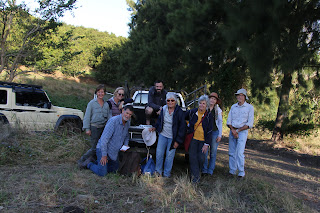Anne, our human GPS with the instincts of a migrating swallow, was not with us that day. So we relied on intuition, following our gut to lead us where we hoped to find ourselves botanising: a place where Clivia robusta grows waist-high on the edge of a sheer cliff.
We had discovered this colony of Clivia the year before, and returned now with the hope of catching them in flower. But again, we were just too late. Still, we were fortunate—clusters of glossy green seeds hung like ripening grapes, and we marvelled at nature’s quiet promise of renewal.
 |
 |
| Clivia robusta AMARYLLIDACEAE Vulnerable A2cd; B1ab(ii,iii,v) South African endemic |
Everything seemed more beautiful than usual. The air was crisp, with not a breath of wind. Birds sang joyfully. The soft, buttery-yellow buds of Diospyros lycioides hung like miniature bells, and the leaves, velvety to the touch, added to the day's magic.
 |
 |
| Diospyros villosa var. villosa EBENACEAE Hairy Star-apple South African endemic |
 |
| Tracy and Uschi looking closely at flowers on a tree. |
 |
 |
| Erythroxylum pictum ERYTHROXYLACEAE Blue-leaved Coca-tree |
At the stream, water burbled and danced through rocks before spilling over the edge, cascading in silver threads all the way down to the Mtamvuna River. Along the forest margin, Hypoestes forskaolii and Phaulopsis imbricata were in flower, brushing colour onto the understory like watercolour strokes.
 |
 |
| Hypoestes forskaolii ACANTHACEAE |
 |
| Issoglossa sp. |
 |
| Phaulopsis imbricata ACANTHACEAE |
 |
| Xysmalobium involucratum APOCYNACEAE |
Never had I remembered Halleria lucida looking so beautiful. Tubes of fiery orange-red flowers hung directly off the trunk and branches, like flickering flames. It was as if the tree itself had caught fire, not in destruction, but in celebration.
 |
| Halleria lucida STILBACEAE Wild Fuschia |
 |
 |
| Burchellia bubalina RUBIACEAE Wild Pomegranate |
We sat quietly on the forest floor, nestled among the long, arching leaves of Clivia robusta, some well over a metre in length. There was a stillness there—an otherworldly calm—as if, with enough silence and patience, we might catch a glimpse of elves or fairies slipping through the leaf litter.
Perched on the edge of a rock under the leafy canopy, we looked down. It must have been at least 350 metres to the forest floor. From there, we had a bird’s-eye view of the tree canopy. We spotted Cussonia and Bersama lucens in seed, and Rhoicissus digitata winding its five-fingered leaves skyward like green stars climbing into the light.
 |
 |
| Bersama lucens MELIANTHACEAE Glossy White Ash |
 |
| Cussonia sp. ARALIACEAE |
 |
| A gall on the Rhoicissus digitata |
In this enchanted forest, Hyperacanthus amoenus grows—a species said to give off an intoxicating scent when in flower. One can only imagine the perfume drifting through the trees.
Zanthoxylum capense, commonly known as the knobwood, is a small tree or shrub distinguished by its spiny branches and citrus-scented leaves when crushed. With age, the lower spines often lose their rigidity, giving older specimens a softened appearance. This species is well known in traditional medicine for its wide range of uses. Crushed leaves are used to reduce fever, while various parts of the plant are employed as a remedy for snake bites and toothaches. Twigs are commonly used as natural toothbrushes — they contain antimicrobial compounds that help reduce plaque and promote oral hygiene. Z. capense is a remarkable example of a multipurpose medicinal plant found in southern Africa. - Some of the botanical details mentioned here are adapted from “Pooleys Trees of Eastern South Africa – A compete guide” by Richard Boon.
 |
| Zanthoxylum capense RUTACEAE Wag-'n-bietjie |
As we meandered back, the golden afternoon light caught the pink flowering stems of Agathosma ovata. On the hillside, Syzygium cordata's stood like sentinels, full of character, gnarled and proud. We searched for Habenaria filicornis, the delicate green orchid we had once seen in this very grassland—its flowers like tiny green people dancing in the wind. But this time, we may have just missed them.
Still, we carried the magic of the day with us—reunited with full hearts, bringing back our “takkies” from the forest, a bit like show-and-tell. Nearing the exit, we stopped to admire a Fish Eagle and four Crowned Cranes, perched regally on the ghostly trunks of dead Eucalyptus. It was a truly magical day.
 |
| Dalechampia capensis EUPHORBIACEAE |
 |
| A ghost tree in the forest. |
 |
| Eugenia verdoorniae MYRTACEAE Small-leaved Myrtle Near Threatened B1ab(iii,v) South African endemic |
 |
| Agathosma ovata RUTACEAE |
 |
| Senecio helminthioides ASTERACEAE |
 |
| Tracy, Alf and Sarel. |
 |
 |
| Pondoland CREW Back: G.B-W, M.A, S.H, S.C, D.M, U.T, T.T & A.H. A special thanks to our teachers, who so freely share their botanical knowledge and guide us with patience and passion. |
“I took a walk in the woods and came out taller than the
trees.” – Henry David Thoreau




























